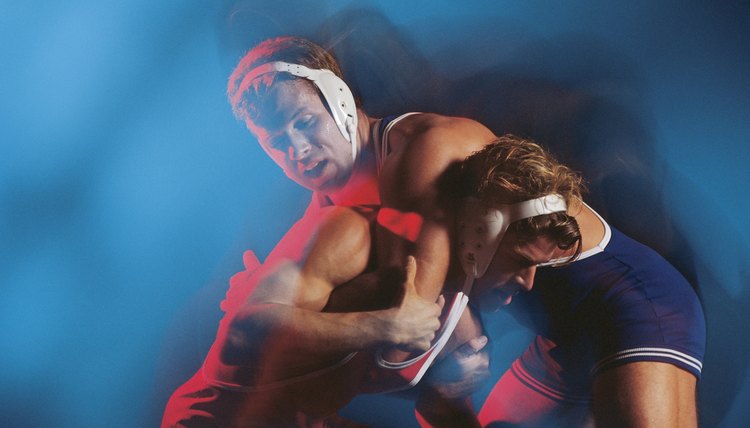Drills for a Faster Shot in Wrestling

The takedown is a bread-and-butter move in wrestling, the way one wrestler takes his opponent to the ground and establishes control. Takedowns to the lower half of the body begin with a "shot": diving toward the opponent's legs to grab them. The faster your shot is, the more likely you are to capture the legs before your opponent can react with a countering move.
Knee Tag
To begin a session of knee tag, two wrestlers stand facing one another as if beginning a regular match. When play begins, the wrestlers try to slap one another on the front, side or back of the knee. Each uses his hands and leg position to keep the other from scoring. This drill works on the basic speed of a shot: going for an opponent's legs as quickly as possible, without telegraphing your intent ahead of time.
Clinch Fighting
Wrestlers spend a lot of time in the clinch, their heads close together with one or more hands gripping the opponent's head and shoulder. A good clinch places your forearm on the opponent's center line, along and parallel to the sternum. This gives maximum control to set you up for a fast shot. In clinch fighting, two wrestlers enter a clinch and compete to see who can maintain that center line control the longest. Although this doesn't work the speed of a shot itself, it develops a wrestler's ability to set up for a shot -- an attribute that results in a faster shot than raw speed.
Bear Hug Drill
Another drill that works the positioning and body control attributes that can mean a faster shot, the bear hug begins in the same position as clinch fighting. From there, each wrestler attempts to get behind his opponent and lock his hands in a bear hug from behind. Once a wrestler scores, the other pushes free and play begins again. Ducking around and behind a skilled opponent develops your ability to see an opening and take it before the changing positions in a wrestling match make that opening disappear.
Up-and-Down
An up-and-down shot fakes towards an opponent's face before diving in to attempt the takedown. The theory is that an opponent will flinch upwards and expose his legs more openly to the shot. To do an up-and-down drill, you flick your hands at your opponent's face, then dive in for your shot. Drilling on up-and-down increases your overall speed because you train to move farther in a short period. Simultaneously, it drills a reflex into you that gives you more time to complete your shot.
Takedown Practice
Hesitation and conscious thought slow down your shot. Any takedown you attempt must be part of your muscle memory -- a conditioned reflex you can apply start to finish with a single mental impulse. The only way to do this is to drill your takedowns hundreds of times against a live training partner. More than any other drill, this kind of practice will develop the raw speed of your shots.
References
- NCAA Publications: Wrestling 2010 and 2011 Rules and Interpretations
- "Coaching Wrestling Successfully"; Dan Gable; 1999
Writer Bio
Jake Wayne has written professionally for more than 12 years, including assignments in business writing, national magazines and book-length projects. He has a psychology degree from the University of Oregon and black belts in three martial arts.
